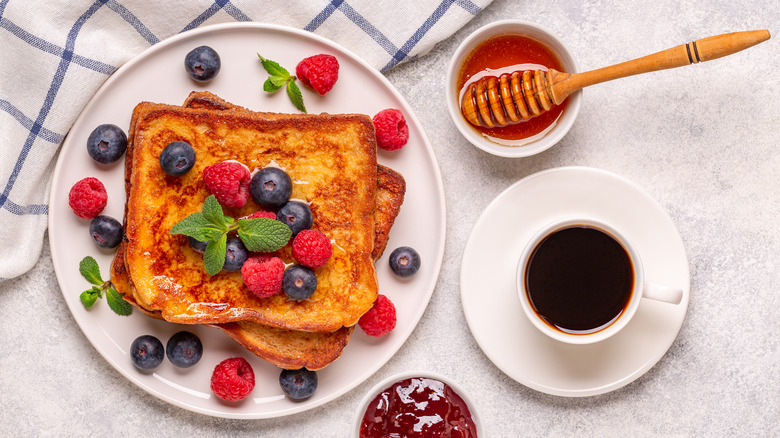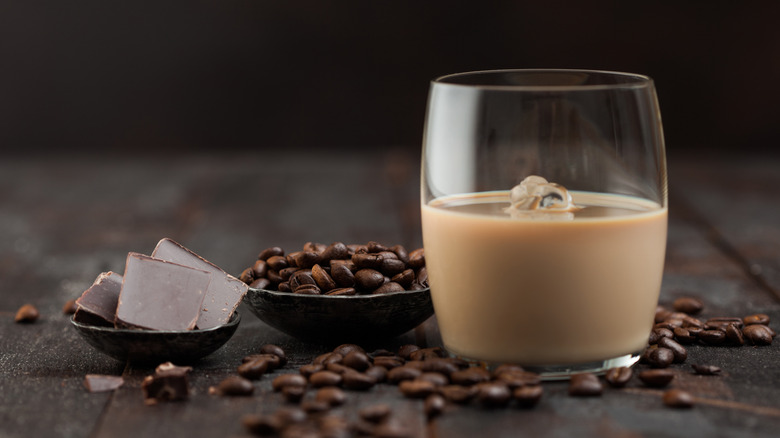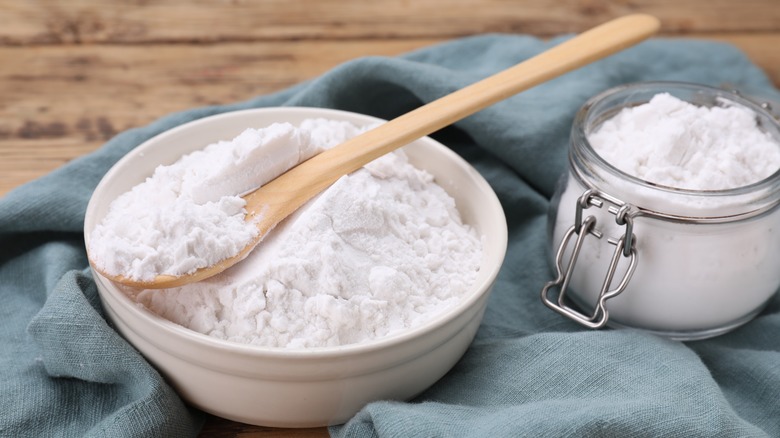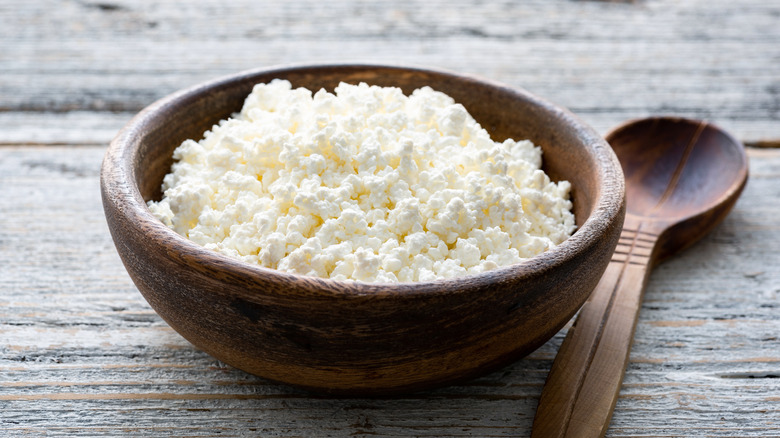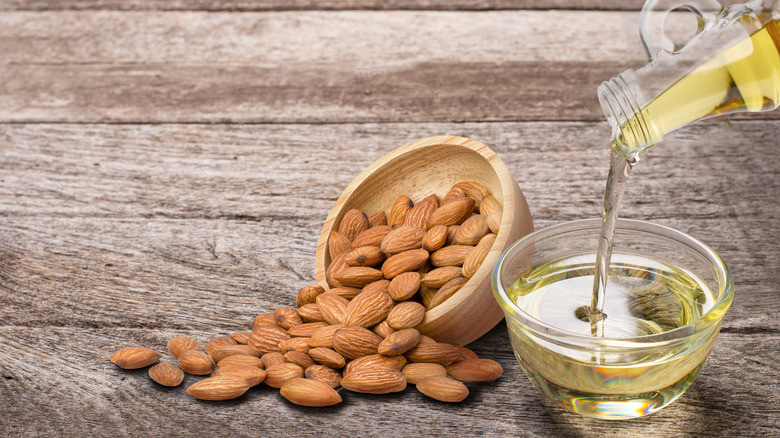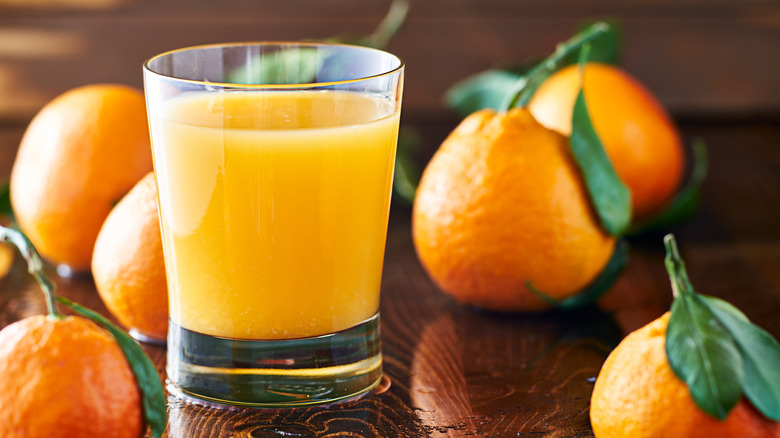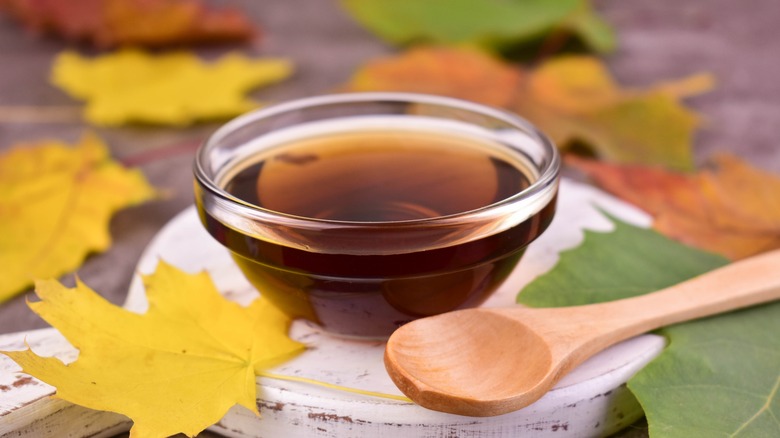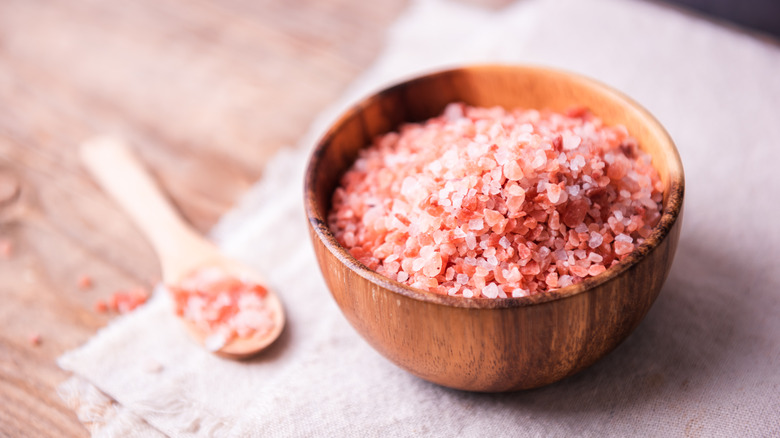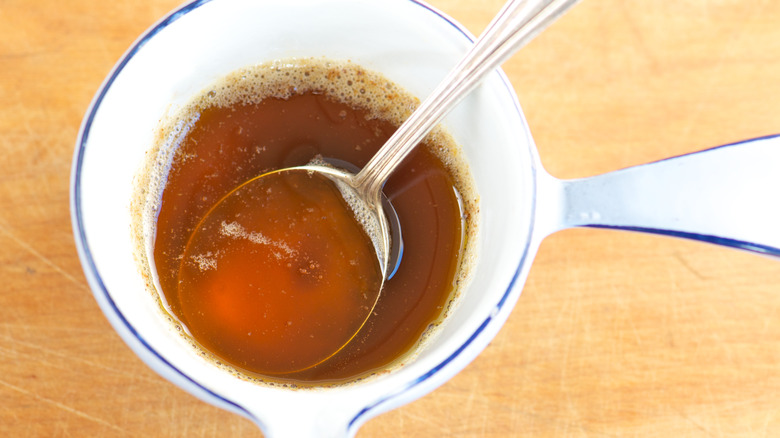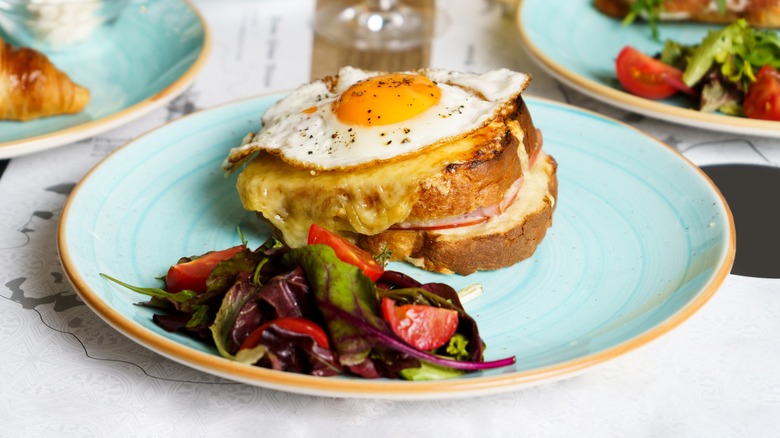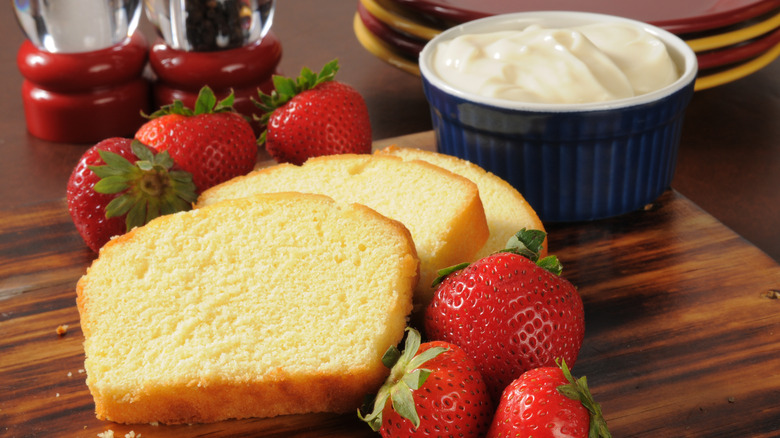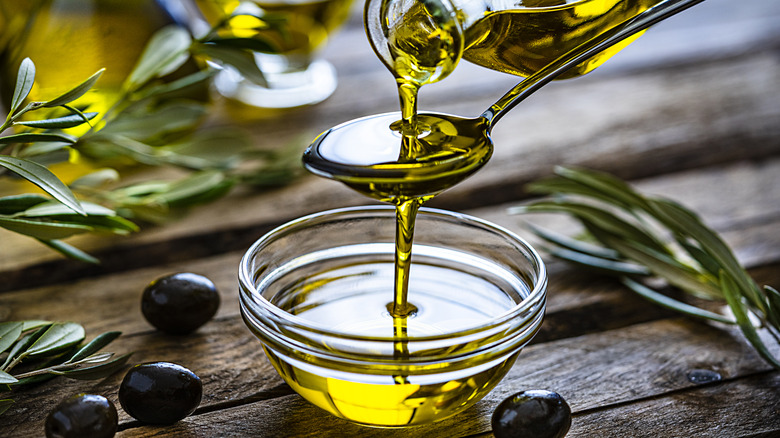14 Ingredient Swaps That Will Make Your French Toast Taste Like A Pro's
Fluffy, moist, and rich, a classic French toast is one of those breakfast dishes that screams special occasion. Indeed, in the 18 years that I owned and was the chef of a food-centric bed and breakfast, it was one of my most popular and frequently requested specialties. People of all ages love the indulgent and satisfying flavors that can be coaxed out of slightly stale bread when it is soaked in a rich egg custard and pan-fried in butter.
While there are countless hacks you can follow to help you make a superior French toast, there are some tricks of the trade in terms of ingredient swaps that professional chefs use to transform their recipes into something extraordinary. Many of these are easy to execute at home and utilize ingredients you likely already have lying around. Read on to find out how you can make your French toast taste like a pro's with some simple substitutes.
1. Use melted ice cream instead of egg custard
One substitution is the use of melted ice cream in place of an egg custard for soaking your day-old bread. The technique is sound when you consider that ice cream is generally made from a custard containing copious quantities of egg yolks whisked together with sugar. These are tempered with a combination of cream, milk, sugar and seasonings, before the entire mixture is slowly thickened over a low heat. The resulting rich and velvety blend is transferred to an ice cream machine, where it is perfectly frozen.
The key to working with melted ice cream instead of an egg custard is to select a high-quality brand. This is not the time to purchase a budget brand or to use ice cream that is made without eggs or dairy. Many of these have fillers, additives, and emulsifiers that can cause your French toast to burn when you fry it up. I also recommend playing around with different flavors. If you enjoy chocolate or strawberry ice cream, imagine how tasty these would be in French toast delivery format!
2. Swap the milk with Bailey's Irish Cream or another cream-based liqueur
Adding a splash of booze to a recipe can amplify the flavor and aroma of a dish, as well as impact the texture, helping to tenderize foods. In the context of a French toast recipe, the obvious place to infuse alcohol is into the egg custard. While you can toss in a splash of bourbon, Grand Marnier, or amaretto, try substituting some of the milk in the recipe with Bailey's Irish Cream, or another cream-based liqueur. What sets Bailey's and other cream-based liqueurs apart from many types of alcoholic beverages is their dairy content. The basic recipe for Bailey's combines cream with Irish whiskey, vanilla, and cocoa powder. These are some of the same ingredients of a custard base for French toast.
I recommend a less is more approach to using liqueur in French toast batter. Rather than swapping all of the milk with Bailey's, only do so with half of it; this will prevent the dish from becoming too boozy. And, keep in mind, not all of the alcohol will evaporate in the process of frying up your French toast. A significant percentage of the alcohol will remain, making this iteration of this dish inappropriate for children, those who are pregnant, or anyone else who is abstaining.
3. Put cornstarch in the milk in place of the eggs
While eggs are generally the base for a classic French toast batter, there are a number of reasons why you may opt to leave them out of the recipe. If this is the case, you will need to find an alternative to replace the magical properties of an egg in a custard. The basic purpose is to help thicken it and to bind it to the bread. One of the best alternatives to eggs to help achieve these same goals is cornstarch.
Cornstarch is often used as a thickener in soups and sauces, in the form of a slurry, so its infusion into French toast batter is not exactly revolutionary. Combine 1 tablespoon of cornstarch per 1/2-half cup of milk or non-dairy milk, and whisk this thoroughly before dunking your bread into the batter. You may notice that French toast made with cornstarch develops a distinctly crisp exterior and tender, fluffy center, something that is highly appealing. It also creates something of a barrier between the butter and maple syrup used to garnish the dish, helping prevent it from making the French toast soggy.
4. Substitute cottage cheese for milk in the batter
We all know that cottage cheese is a high-protein dairy product that can help boost the nutritional profile of many of our favorite recipes. But did you know that it can also be transformed into a delectable custard batter for French toast and gives it a distinct tangy flavor? You can swap the milk one-for-one with cottage cheese for a healthy and flavorful French toast your family will keep requesting.
You may wonder how the curd-like texture of cottage cheese could possibly make for a smooth, creamy egg custard. Before incorporating it into your batter, whiz the cottage cheese in a food processor or blender until it is smooth and lump-free. For this purpose, I highly recommend using a quality, full-fat, small-curd cottage cheese brand, like Kalona SuperNatural. This brand is distinctive because of its cream layer, which, when blended together with the curds, yields a luscious texture that is as good as full-fat milk or heavy cream. Be sure to add plenty of spices and vanilla to offset the tanginess of the cottage cheese and add some complexity to the custard batter.
5. Amplify flavor with Chinese 5 Spice instead of just cinnamon
When assembling the custard batter for French toast, spices often make an appearance in the recipe. Though cinnamon is the tried and true sweet spice du jour, its flavor alone can be overwhelming to some. Though you can mix and match your own ground spices to create a combination you are fond of, a pre-mixed spice blend is always convenient and easy to use. Most of us are familiar with pumpkin or apple pie spice mixes because they are commonly used in making cakes and pies around the holidays. That said, there is a blend that is more exotic and will transform your French toast into something truly special: Chinese Five spice.
This blend typically combines cinnamon, cloves, fennel, star anise, and Sichuan peppercorns, for a complex flavor that will perk up all of your taste buds. This distinct assemblage of spices highlights elements from every one of the five tastes, working equally as well in sweet and savory recipes. I generally recommend a teaspoon of Chinese 5 Spice for every cup of milk used in the custard batter. Though a little goes a long way, you do want enough of the spice blend to both smell and taste it when it hits the melted butter in the frying pan.
6. Trade out half the vanilla extract with almond extract
Using vanilla beans or extract is a common addition to most baked goods and dessert recipes. That said, there are plenty of other extracts that can pack a punch in the flavor and aroma department. One that I enjoy is almond extract. The nuttiness of this particular type of extract enhances the caramelized flavor of the finished French toast, amplifying the Maillard reaction that occurs when it is fried in butter.
Before you choose an almond extract, you should check the label to make sure it is pure almond, not imitation extract. While pure almond extract is made by cold-pressing almonds, or the pits of stone fruits, and infusing these in water and alcohol, the imitation variety is produced using artificial ingredients that mimic the aroma and flavor of these nuts. This facsimile is seldom as flavorful or pleasing to your nose as the real deal, and, in some cases, can have an odd aftertaste.
Though you can completely eliminate the vanilla and use exclusively almond extract, I personally recommend using both. By using half vanilla and half almond extracts you get the best of all worlds, developing a much more intense and complex flavor and smell that will transform your French toast.
7. Supplement some of the milk with orange juice
Among the most common types of alcohol added to baking are Grand Marnier and Triple Sec. These are both orange-flavored liqueurs that add amazing flavor and aroma to your custard batter. That said, as previously noted, the alcohol does not fully evaporate when you cook the French toast, so you may be wondering about an alternative to these for a punch of orange flavor, sans the booze. The answer is — orange juice.
Though I tend to favor pulpy orange juice for drinking, when it comes to baking, this chewy iteration may not be ideally suited to the task at hand. A non-pulpy, high-quality orange juice is what you are looking for. Among my favorites is Simply Orange, which has a freshly squeezed taste without going through all the effort of extracting that liquid gold yourself. Whichever juice you choose, do not completely eliminate the milk. Use half orange juice and half milk for a punch of flavor without too much sugar, which can cause your French toast to burn.
If you really want to get snazzy with the orange flavor, you can also toss in a 1/2 tablespoon of orange blossom water into the batter. This quintessential North African and Middle Eastern ingredient produces a concentrated, almost floral orange essence by distilling orange blossoms. The result is something really nuanced and complex that'll send your French toast into the culinary stratosphere.
8. Exchange the sugar with maple syrup or honey
While white or brown sugar are the gold standard for making a custard base, I often use honey or maple syrup instead. The liquid sweetener helps to produce a smooth batter while infusing it with complex flavor. Be sure to use pure maple syrup, not pancake syrup, which is simply an artificial facsimile of the real deal that is often made from high-fructose corn syrup and flavorings. Real maple syrup comes in various grades, including golden, amber, dark, and very dark, with the darker hued syrups being more robust in flavor.
When it comes to honey, the permutations are virtually endless. There are as many different kinds of honey as there are bees and plants they can feed upon. Many of these have exotic floral notes that can give your French toast a distinctive earthiness that is very unusual and pleasant. Regardless of which maple syrup or honey you use, you will want to pay particular attention to how rapidly you cook your French toast. Opt for a slightly lower cooking temperature to ensure the center of the French toast is fully cooked before the exterior burns.
9. Switch up plain salt with a flavored variety
We all know salt is integral to sweet and savory recipes alike. This is no less relevant when assembling a batter for your French toast. Adding a pinch of salt to your custard batter will help to accentuate the inherent sweetness and amplify all of the other flavors, building complexity and tantalizing your taste buds. Though kosher salt is my go-to when it comes to cooking, there are plenty of specialty flavored salts that would be delightful in a French toast recipe.
Many specialty salts have various minerals in them that give them inherent flavor, like Himalayan pink salt and fleur du sel. One such unique salt that has been making waves with vegans and vegetarians alike is an egg-flavored black variety called kala namak. While it is rich in umami flavor, this is no reason not to use it in a sweet recipe, like French toast. Doing so lends nuance that can make your taste buds perk up.
Other flavored salts achieve their distinctness by being smoked or combined with various spices. These too can help add interest to your French toast that will surprise your guests and promote a sophisticated layering of flavors that you cannot achieve with plain salt.
10. Cook it in brown butter rather than plain
Though some chefs like cooking French toast in an oil with a high-smoke point, like vegetable or canola, I prefer using butter for flavor, aroma, and color. And, while butter is great, there is a variation of this dairy product that is even better — brown butter. Indeed, there are a number of chefs who swear that brown butter is the secret to the best grilled cheese sandwich. If it can work for grilled cheese, it can work equally as well on its not so distant breakfast cousin, French toast.
When making brown butter, it is important to know the difference between brown versus burnt. The latter can turn this delicacy into a bitter, unpalatable fat, rather than one that can confer a rich, caramelized, toasty flavor and color to your French toast. For the best brown butter, use unsalted butter and fabricate it in a small stainless saucepan. As the fat in the butter melts, water will begin to evaporate, leaving behind milk solids. Once the butter stops spattering and has transformed into a nutty, golden brown hue, remove it from the heat. This brown butter is now ready for frying up the ultimate French toast.
11. Top it with preserves instead of maple syrup
Sure, pure maple syrup on pancakes or French toast is standard, and while there is nothing wrong with this, sometimes I like to think outside the box when looking for ways to jazz up my breakfast toppings. One ingredient that I like to keep on hand are various flavors of preserves, spread, jellies, and marmalades. Among my favorites are the varieties offered by the Bonne Maman brand. This French brand has some dynamite flavors, like cherry, apricot, and wild blueberry, that are crafted with less sugar and more fruit, accentuating the natural flavor of each type of fruit used.
When turning a preserve, spread, jelly, or marmalade into a topping for French toast, I generally will loosen it up using some water and add a bit of vanilla extract to help infuse it with flavor. I heat this up until the coagulated preserves are melted and turned into a more syrup-like consistency. I drizzle this over the French toast along with fresh fruit and a dusting of powdered sugar for the ultimate delight.
12. Stuff it with savory ingredients instead of sweet ones
Stuffing French toast with a filling of cream cheese and jam, or some other sweet combination, is a common way of elevating this popular breakfast food. That said, one of my favorite ways of surprising breakfast guests is to present them with a savory variation on a stuffed French toast. Savory stuffings can vary, but some great options include pesto, fresh mozzarella, and prosciutto, or a play on shakshuka, using a spread made from peppers, tomatoes, and caramelized onions seasoned with smoked paprika and cumin.
When making a savory stuffed French toast, you will want to switch up the seasoning on the egg custard to follow suit. One way of doing this is to toss some freshly grated Parmesan cheese into the batter, which will create an umami-rich, golden brown crust. Another somewhat unusual, but highly effective, way of transforming French toast into a savory delight is to use condensed canned tomato soup in the custard. The thick, condensed soup combined with eggs and savory spices, like paprika and Italian seasoning, will give your bread a unique light red hue and a distinctive, luxurious texture, as long as you don't over soak it.
13. Replace the bread with slices of pound cake
One of the most important components of French toast is the bread, and choosing the right kind can make or break your recipe. The perfect vessel for this dish is a bread that is sturdy enough to withstand the egg custard, yet supple enough to stay tender when cooked. It should also be thick enough to not fall apart. While there are a few standards, like brioche and challah, one option that is sure to delight and shock your guests is pound cake. Pound cake alone is a luxurious and decadent treat, and when soaked in a rich egg custard and pan-fried it takes it to a whole new level of indulgent.
A true pound cake contains 1 pound each of flour, sugar, eggs, and butter. These are all baked in a loaf pan, which gives it the shape of bread and the texture of a dense, rich cake. Slices of pound cake are almost sponge-like in their absorbency, taking on the custard readily, so be careful not to oversaturate them. Once they have been delicately bathed in custard, pan-fry them in butter until golden brown.
14. Make it in olive oil mixed with butter
While butter is the go-to choice for pan-frying French toast to obtain that perfect, crisp, golden brown texture, swapping half of this dairy with some extra virgin olive oil may be the hack your taste buds have been dreaming of. I often combine the two fats to help prevent the butter from burning, while maintaining that rich flavor. This works equally as well when you are seeking to cook French toast at a lower temperature so that it has a chance to cook all the way through before the exterior of the bread has burnt to a crisp. I typically finish my French toast in the oven to accommodate for this, but by using both fats, you can eliminate this step.
An added bonus to using olive oil in conjunction with your butter is a distinctive sweet and savory layering of flavor. Quality extra virgin olive oil is known for having unique floral, earthy, and even peppery notes. These will play off of the sweet elements in your batter, like sugar, vanilla, and spices, balancing them out and creating a sophisticated and complex mélange of flavors in your mouth.
